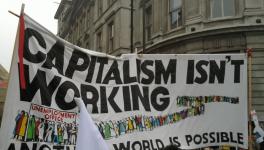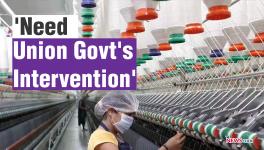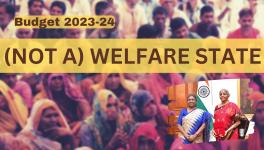Inequality-Led Slowdown Can’t be Tackled by Slashing Corporate Tax
Image for representational use only.Image Courtesy : HuffPost India
Signs of slowdown are evident in Indian economy today. It is not only about the automobile sector, the growth rate of the entire economy is falling. Empirical evidence suggests that the unemployment rate is also rising in the economy. The wage rates of the vast majority of masses has remained constant, if not fallen, in real terms for the past five-six years. In short, the economy is in bad shape and the situation is deteriorating. But what has the government done recently (on September 20) to tackle the situation of falling growth rate? It has slashed the tax rate on corporate profit to protect the net profit and give a fiscal stimulus to boost the economy. Will that help?
To formulate a policy for the revival of the economy, it is important to understand the reasons behind this slowdown. Some people have pointed out that demonetisation and goods and services tax (GST) are the root causes. Both these factors may have triggered the slowdown, but the real cause of falling growth rate is much deeper, in my view. The enormous rise in inequality, particularly during the high growth phase, has caused a falling rate of profit, which, in turn, has resulted in falling rate of investment and growth.
About 125 years ago, Karl Marx had talked about this falling rate of profit in chapter13 of volume 3 of his volume, Capital. Subsequently, Polish economist Michal Kalecki developed this theory further, saying that a rise in inequality may lead to a falling rate of profit under capitalism and cause a crisis.
The logic is very simple. If the income of a vast majority of people (workers) does not rise at the rate in which the productive capacity rises, then there would be tendencies of overproduction at the aggregate level. The size of the domestic market is dependent on the purchasing power of common people. If the growth rate of that is lower than the growth rate of investment at an aggregate level, then the potential output would be higher than the aggregate domestic demand for commodities and services. If aggregate demand happens to be lower than the aggregate supply, then even if the producers produce more, the extra output would not be sold in the market at the ongoing prices and profit would not be realised in absence of any expanding external (export) market. In that case, the expected future rate of profit would fall and the investment rate would come down. As a result, the growth rate of the economy would also fall.
As inequality increases in the economy and income distribution favours the richer section of the population, the aggregate domestic demand for goods and services comes down. This happens because a larger proportion of the poorer section’s income is consumed, while the consumption propensity of the richer section of the population is relatively lower, on an average. Saving does not add anything to the aggregate demand for commodities and services in the economy. Therefore, rise in inequality can cause a slowdown.
The Annual Survey of Industry’s data shows that in the organised manufacturing sector in India, the share of wages and salaries in total value added came down substantially, particularly during the high growth period. Currently, the share of wages is just around 15% of net value added of the organised manufacturing sector. Therefore, the vast majority of workers and employees in the organised manufacturing sector have got 15% share of the pie. The larger share has gone in favour of profit earners, interest earners and shareholders. The majority of workers are in the unorganised sector of manufacturing, construction and services. Most of them do not even get the government prescribed minimum wage rate, which anyway is very low.
The situation of farmers’ income is worse. Small and marginal farmers and landless agricultural labourers are so poor that they hardly have any purchasing power. If we look at non-agricultural rural labourers, the situation is equally bad, if not worse. There is huge gender-wage gap in the country. Labour Bureau data on rural wages for 13 agricultural and 12 non-agricultural activities shows that the average growth rate of real wages has been zero during the past four-five years. But the per capita GDP (gross domestic product) has grown at an annual rate of 6-7% during this period. Needless to say, the unemployed could not earn any income anyway. Therefore, the entire increment in real national income has been pocketed by the smaller proportion of the rich population. The rich have become richer and a vast majority of the poorer section has become poorer, at least in a relative sense.
All empirical evidence (based on National Sample Survey Organisation surveys and otherwise) have indicated that inequality has been rising in the country for quite some time. In fact, the profit-led growth trajectory under the ‘neo-liberal’ regime is bound to increase inequality. A justification was given that if everybody becomes relatively better off (in terms of real income), then inequality will not matter. Even if inequality rises in the society, people would be relatively happier. But, this is not sustainable.
Even if we keep aside socio-political problems, which accrue from inequality, the inequality-creating growth process cannot sustain itself because of the reasons mentioned above. Alternatively, wage-led growth is possible by ensuring better income distribution in the economy and thereby improving the overall consumption propensity. In that case, a little higher government expenditure or investment or export would be able to raise the GDP more than proportionately. This growth process would be sustainable until and unless the economy reaches full employment or full capacity level of output. Currently, the economy is operating well below full employment or full capacity situation. In fact, unemployment is one of the biggest problems facing our economy.
If the net export is increased, it may generate some extra demand in the economy at the aggregate level. However, export demand depends on the growth of economies that are our main export destinations. The developed world is also not growing at a fast rate, which is beyond our control. The government can surely inject extra demand in the economy by incurring a larger fiscal deficit. If people pay less tax, their disposable income will rise.
Again, if the government spends more money, people (directly or indirectly) earn more income. When part of that income is spent, some other people will earn more income. This would create demand for goods and services and so on. If there is unutilised productive capacity and unemployed labour in the economy, more output would be generated. This is called the Keynes-Kahn multiplier process in the literature of economics. But, the space for expansionary fiscal policy is also limited because of the Fiscal Responsibility and Budget Management (FRBM) Act in India.
As per the governments’ September 20 announcement, the estimated revenue foregone due to the tax concessions to corporates would be around Rs 1.45 lakh crore or more than 0.75% of GDP. This would worsen the inequality situation and would not address the root cause of inequality-led slowdown.
Instead of giving tax relief to corporates, the government should have spent this money on infrastructure and social sector (health, education, MGNREGA, the rural job guarantee scheme etc.), which would have worked as a fiscal stimulus as well as reduced inequality by favouring the poor and vulnerable sections of the population. If the government has to operate under FRBM restrictions, then the reduction in tax revenue will further squeeze the space for infrastructure and social sector spending.
The purchasing power of poor people will rise only if the government enhances social sector spending. If the government incurs more pro-poor expenditures, inequality would naturally come down. Hence, without giving corporates such a massive tax relief, had the government spent extra (particularly in infrastructure and social sector), it would have been much more effective in targeting the root cause of the economic slowdown. But, the government chose to do just the opposite.
Surajit Das is Assistant Professor, Centre for Economic Studies and Planning, Jawaharlal Nehru University, Delhi. The views are personal.
Get the latest reports & analysis with people's perspective on Protests, movements & deep analytical videos, discussions of the current affairs in your Telegram app. Subscribe to NewsClick's Telegram channel & get Real-Time updates on stories, as they get published on our website.























